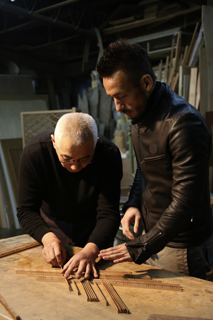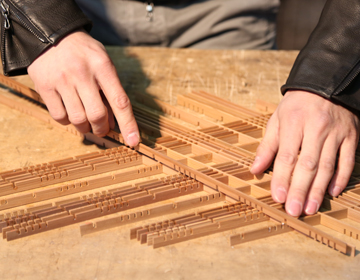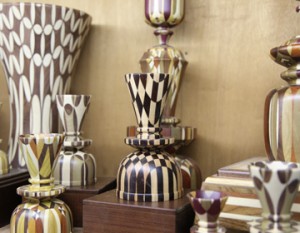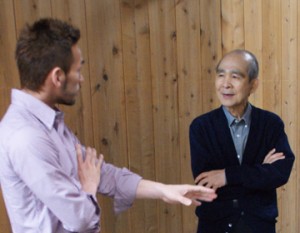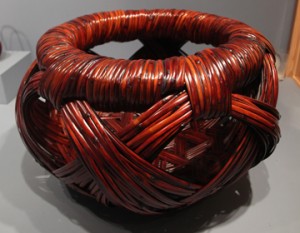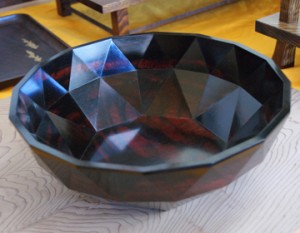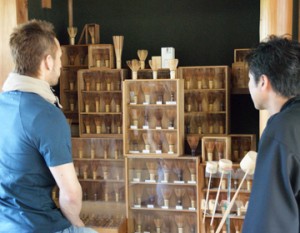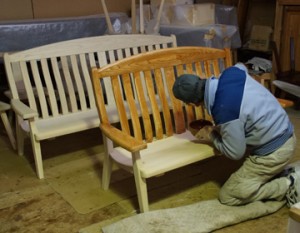Inheriting the family business from his father
Shinichi Sugawara whom we interviewed wears 2 hats; one is ”Tategushi” (door maker) and the other one is ”Sashimonoshi” (cabinet maker). He inherited the long family business of door making from his father, and repaired Kaneiji’s old Honbo Front Gate (Kuromon) and was in charge of restoring the doors in the main hall of Motsuji.
And as a cabinet maker, he established ”Kobo Ichinoha” and created some boxes which were exhibited at Japan Kogei Show. Using his skills as a cabinet maker, he created Furosaki Byobu that is used in tea rooms.
”I got to make doors for a tea master’s house and that was when I became interested in cabinet making”. Sugawara told us. He talked with many people he met through his work and at the exhibitions, and learned many aspects of classical design and aesthetics.
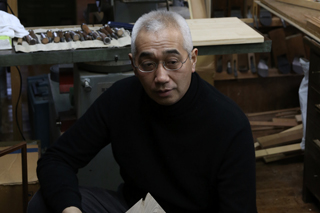
Making the most of the “materials” rather than the technology
While Nakata was admiring summer ”Shoji” with ”Kumiko” work made from natural Akita cedar, Sugawara said, ”When I was young, I was only making things with small intricate designs.” And our eyes went to the wooden patterns. Nakata said, ”I thought this was done on purpose, with a pattern or something.” What he thought was artificial were patterns created by nature.
”When I was young, I was thinking more about using complicated techniques as a woodworker. But now, I place more emphasis on the designs of the material itself. So it is becoming much simpler.” he commented.
He showed us a tea box that was still in production. The wood that is used is maple and Japanese yew. ”Now, I will shave the surface to finish it up but for the last polish, I use equisetum which has been used from the old days.” he told us while polishing the surface of the tea box. Soon, the surface of the wood shined beautifully. Sugawara uses the precious Jindai Sugi (Japanese Cedar) too. Jindai Sugi is a very rare material that is only available on the market when they find cedar that is several hundred years old, which has been buried in the ground for several thousand years. Wood that has lived for a long time and matured, changes into a beautiful art piece in Sugawara’s hands.
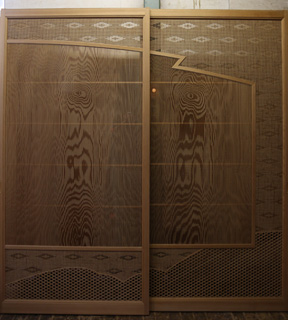
Experiencing “kumiko”
We got to experience making ”kumiko”. Nakata commented, ”I am not very good with this kind of work.” To which Sugawara replied, ”To be honest, I am not that coordinated either.”
”But even if you aren’t coordinated, just focus on being careful and work with patience, and it’ll work out in the end.” he laughed. He combined all the wooden pieces and finished making a board of ”kumiko”.
Sugawara has been working for many years and has been exhibiting his work at craft shows but when we asked, ”What do you want to do from now?”, he replied ”There are many more things I want to do.”
”There are many things I want to do. For example, I would love to coordinate the whole living space. I was involved in building a house as part of woodworking, but I have never started anything from scratch. So I want to challenge coordinating one whole house.” Sugawara told us. Creating items ranging from boxes, woodwork to living space. It really is interesting to learn the Japanese culture of woodworking. We will keep following Sugawara’s work.
